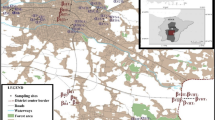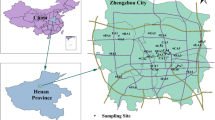Abstract
Spatial characteristics of the properties (dust organic material and pH), concentrations, and enrichment levels of toxic metals (Ni, Hg, Mn and As) in street dust from Xiandao District (Middle China) were investigated. Method of incorporating receptor population density into noncarcinogenic health risk assessment based on local land use map and geostatistics was developed to identify their priority pollutants/regions of concern. Mean enrichment factors of studied metals decreased in the order of Hg ≈ As > Mn > Ni. For noncarcinogenic effects, the exposure pathway which resulted in the highest levels of exposure risk for children and adults was ingestion except Hg (inhalation of vapors), followed by dermal contact and inhalation. Hazard indexes (HIs) for As, Hg, Mn, and Ni to children and adults revealed the following order: As > Hg > Mn > Ni. Mean HI for As exceeded safe level (1) for children, and the maximum HI (0.99) for Hg was most approached the safe level. Priority regions of concern were indentified in A region at each residential population density and the areas of B at high and moderate residential population density for As and the high residential density area within A region for Hg, respectively. The developed method was proved useful due to its improvement on previous study for making the priority areas of environmental management spatially hierarchical and thus reducing the probability of excessive environmental management.





Similar content being viewed by others
References
Al Rmalli SW, Harrington CF, Ayub M, Haris PI (2005) A biomaterial based approach for arsenic removal from water. J Environ Monit 7(4):279–282
Bourennane H, Douay F, Sterckeman T, Villanneau E, Ciesielski H, King D, Baize D (2010) Mapping of anthropogenic trace elements inputs in agricultural topsoil from Northern France using enrichment factors. Geoderma 157(3–4):165–174
Cesari D, Contini D, Genga A, Siciliano M, Elefante C, Baglivi F, Daniele L (2012) Analysis of raw soils and their re-suspended PM10 fractions: characterisation of source profiles and enrichment factors. Appl Geochem 27(6):1238–1246
Charlesworth S, De Miguel E, Ordóñez A (2011) A review of the distribution of particulate trace elements in urban terrestrial environments and its application to considerations of risk. Environ Geochem Health 33(2):103–123
Chen H, Lu XW, Li LY (2014) Spatial distribution and risk assessment of metals in dust based on samples from nursery and primary schools of Xian, China. Atmos Environ 88:172–182
Chen JQ, Wang ZX, Wu X, Zhu JJ, Zhou WB (2011) Source and hazard identification of heavy metals in soils of Changsha based on TIN model and direct exposure method. T Nonferr Metal Soc 21(3):642–651
Christoforidis A, Stamatis N (2009) Heavy metal contamination in street dust and roadside soil along the major national road in Kavala’s region, Greece. Geoderma 151(3–4):257–263
CNEMC (China National Environmental Monitoring Center) (1990) Background values of soil elements in China, 1st edn. Chinese Environmental Science Press, Beijing (in Chinese)
Duker AA, Carranza EJM, Hale M (2005) Arsenic geochemistry and health. Environ Int 31(5):631–641
Ferreira-Baptista L, De Miguel E (2005) Geochemistry and risk assessment of street dust in Luanda, Angola: a tropical urban environment. Atmos Environ 39(25):4501–4512
Hu X, Zhang Y, Luo J, Wang T, Lian H, Ding Z (2011) Bioaccessibility and health risk of arsenic, mercury and other metals in urban street dusts from a mega-city, Nanjing, China. Environ Pollut 159(5):1215–1221
Hughes MF (2002) Arsenic toxicity and potential mechanisms of action. Toxicol Lett 133(1):1–16
Jiang Y, Hu X, Yves UJ, Zhan H, Wu Y (2014) Status, source and health risk assessment of polycyclic aromatic hydrocarbons in street dust of an industrial city, NW China. Ecotoxicol Environ Saf 106:11–18
Kükrer S, Şeker S, Abaci ZT, Kutlu B (2014) Ecological risk assessment of heavy metals in surface sediments of northern littoral zone of Lake Çıldır, Ardahan, Turkey. Environ Monit Assess 186(6):3847–3857
Kurt-Karakus PB (2012) Determination of heavy metals in indoor dust from Istanbul, Turkey: estimation of the health risk. Environ Int 50:47–55
Li H, Qian X, Hu W, Wang Y, Gao H (2013) Chemical speciation and human health risk of trace metals in urban street dusts from a metropolitan city, Nanjing, SE China. Sci Total Environ 456–457:212–221
Li F, Huang JH, Zeng GM, Yuan XZ, Liang J, Wang XY (2012) Multimedia health risk assessment: a case study of scenario-uncertainty. J Cent South Univ 19(10):2901–2909
Li ZW, Zeng GM, Zhang H, Yang B, Jiao S (2007) The integrated eco-environment assessment of the red soil hilly region based on GIS—a case study in Changsha City, China. Ecol Model 202(3–4):540–546
Liu E, Yan T, Birch G, Zhu Y (2014a) Pollution and health risk of potentially toxic metals in urban road dust in Nanjing, a mega-city of China. Sci Total Environ 476–477:522–531
Liu M, Yang Y, Yun X, Zhang M, Li QX, Wang J (2014b) Distribution and ecological assessment of heavy metals in surface sediments of the East Lake, China. Ecotoxicology 23(1):92–101
Lu X, Wang L, Li LY, Lei K, Huang L, Kang D (2010) Multivariate statistical analysis of heavy metals in street dust of Baoji, NW China. J Hazard Mater 173(1–3):744–749
Luo XS, Yu S, Li XD (2011) Distribution, availability, and sources of trace metals in different particle size fractions of urban soils in Hong Kong: implications for assessing the risk to human health. Environ Pollut 159(5):1317–1326
Mandal BK, Suzuki KT (2002) Arsenic round the world: a review. Talanta 58(1):201–235
MEPPRC (2014) Technical guidelines for risk assessment of contaminated sites (HJ 25.3–2014). Ministry of Environmental Protection of the People’s Republic of China, Beijing (in Chinese)
National Environmental Protection Agency of China (1995) Environmental Quality Standard for Soils (GB 15618–1995). China Environmental Science Press, Beijing (in Chinese)
Nelson DW, Sommers LE (1982) Total carbon, organic carbon and organic matter. In: Page AL, Miller RH, Keeny DR (eds) Methods of soil analysis, part 2, chemical and microbiologiacl properties, 2nd edn. American Society of Agronomy, Inc. Madison
Nyamangara J (1998) Use of sequential extraction to evaluate zinc and copper in a soil amended with sewage sludge and inorganic metal salts. Agr Ecosyst Environ 69(2):135–141
Pan YM, Yang GZ (1988) Hunan soil background values and research methods. Chinese Environmental Science Press, Beijing (in Chinese)
Pandey B, Agrawal M, Singh S (2014) Coal mining activities change plant community structure due to air pollution and soil degradation. Ecotoxicology 23(8):1474–1483
Peña-Fernández A, González-Muñoz MJ, Lobo-Bedmar MC (2014) Establishing the importance of human health risk assessment for metals and metalloids in urban environments. Environ Int 72:176–185
Saeedi M, Li LY, Salmanzadeh M (2012) Heavy metals and polycyclic aromatic hydrocarbons: pollution and ecological risk assessment in street dust of Tehran. J Hazard Mater 227–228:9–17
Shi G, Chen Z, Bi C, Li Y, Teng J, Wang L, Xu S (2010) Comprehensive assessment of toxic metals in urban and suburban street deposited sediments (SDSs) in the biggest metropolitan area of China. Environ Pollut 158(3):694–703
Sutherland RA (2000) Bed sediment-associated trace metals in an urban stream, Oahu, Hawaii. Environ Geol 39(6):611–627
Tang R, Ma K, Zhang Y, Mao Q (2013) The spatial characteristics and pollution levels of metals in urban street dust of Beijing, China. Appl Geochem 35:88–98
USEPA (1996) Soil screening guidance: technical background document (EPA/540/R–95/128). US Environmental Protection Agency, Washington DC
USEPA (2001) Supplemental guidance for developing soil screening levels for superfund sites (OSWER 9355.4–24). US Environmental Protection Agency, Washington DC
US Department of Energy (2004) RAIS: risk assessment information system. US Department of Energy, Washington DC
Van den Berg R (1995) Human exposure to soil contamination: a qualitative and quantitative analysis towards proposals for human toxicological intervention values. Algemeen Vertaalbureau Muiderkring, Netherlands
Walcek C, De Santis S, Gentile T (2003) Preparation of mercury emissions inventory for eastern North America. Environ Pollut 123(3):375–381
Wei BG, Yang LS (2010) A review of heavy metal contaminations in urban soils, urban road dusts and agricultural soils from China. Microchem J 94(2):99–107
Yang B, Chen Z, Zhang C, Dong J, Peng X (2012) Distribution patterns and major sources of dioxins in soils of the Changsha-Zhuzhou-Xiangtan urban agglomeration, China. Ecotoxicol Environ Saf 84:63–69
Ye X, Qian H, Xu P, Zhu L, Longnecker MP, Fu H (2009) Nephrotoxicity, neurotoxicity, and mercury exposure among children with and without dental amalgam fillings. Int J Hyg Environ Health 212(4):378–386
Yu BB, Wang Y, Zhou QX (2014) Human health risk assessment based on toxicity characteristic leaching procedure and simple bioaccessibility extraction test of toxic metals in urban street dust of Tianjin, China. PLoS One 9(3):e92459
Zhang J, Deng H, Wang D, Chen Z, Xu S (2013) Toxic heavy metal contamination and risk assessment of street dust in small towns of Shanghai suburban area, China. Environ Sci Pollut Res 20(1):323–332
Zhao H, Li X (2013) Understanding the relationship between heavy metals inroad-deposited sediments and washoff particles in urban stormwater using simulated rainfall. J Hazard Mater 246–247:267–276
Zheng N, Liu J, Wang Q, Liang Z (2010) Health risk assessment of heavy metal exposure to street dust in the zinc smelting district, Northeast of China. Sci Total Environ 408(4):726–733
Zhou T, Xi CZ, Dai TG, Huang DY (2008) Comprehensive assessment of urban geological environment in Changsha City. Guangdong Trace Elem Sci 15(6):32–38 (in Chinese)
Zoller WH, Gladney ES, Duce RA (1974) Atmospheric concentrations and sources of trace metals at the South Pole. Science 183(4121):198–200
Acknowledgments
This study was financially supported by the National Natural Science Foundation of China (51178172, 51039001, and 51378190), the Project of Chinese Ministry of Education (113049A), and the Research Fund for the Program for Changjiang Scholars and Innovative Research Team in University (IRT-13R17).
Author information
Authors and Affiliations
Corresponding author
Additional information
Responsible editor: Philippe Garrigues
Rights and permissions
About this article
Cite this article
Li, F., Huang, J., Zeng, G. et al. Spatial distribution and health risk assessment of toxic metals associated with receptor population density in street dust: a case study of Xiandao District, Changsha, Middle China. Environ Sci Pollut Res 22, 6732–6742 (2015). https://doi.org/10.1007/s11356-014-3753-3
Received:
Accepted:
Published:
Issue Date:
DOI: https://doi.org/10.1007/s11356-014-3753-3




